Related Research Articles

The double bass, also known simply as the bass, is the largest and lowest-pitched bowed string instrument in the modern symphony orchestra. Similar in structure to the cello, it has four, although occasionally five, strings.

The guitar is a fretted musical instrument that typically has six strings. It is usually held flat against the player's body and played by strumming or plucking the strings with the dominant hand, while simultaneously pressing selected strings against frets with the fingers of the opposite hand. A plectrum or individual finger picks may also be used to strike the strings. The sound of the guitar is projected either acoustically, by means of a resonant chamber on the instrument, or amplified by an electronic pickup and an amplifier.
A mandolin is a stringed musical instrument in the lute family and is generally plucked with a pick. It most commonly has four courses of doubled metal strings tuned in unison, thus giving a total of 8 strings, although five and six course versions also exist. The courses are typically tuned in an interval of perfect fifths, with the same tuning as a violin. Also, like the violin, it is the soprano member of a family that includes the mandola, octave mandolin, mandocello and mandobass.

The ukulele, also called Uke, is a member of the lute family of instruments of Portuguese origin and popularized in Hawaii. It generally employs four nylon strings.

String instruments, stringed instruments, or chordophones are musical instruments that produce sound from vibrating strings when a performer plays or sounds the strings in some manner.

Zithers are a class of stringed instruments. Historically, the name has been applied to any instrument of the psaltery family, or to an instrument consisting of many strings stretched across a thin, flat body. This article describes the latter variety.
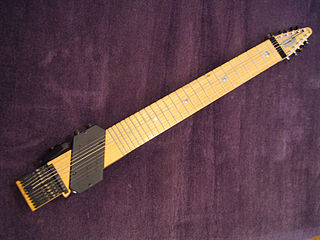
The Chapman Stick is an electric musical instrument devised by Emmett Chapman in the early 1970s. A member of the guitar family, the Chapman Stick usually has ten or twelve individually tuned strings and is used to play bass lines, melody lines, chords, or textures. Designed as a fully polyphonic chordal instrument, it can also cover several of these musical parts simultaneously.

The bouzouki, also spelled buzuki or buzuci, is a musical instrument popular in Greece. It is a member of the long-necked lute family, with a round body with a flat top and a long neck with a fretted fingerboard. It has steel strings and is played with a plectrum producing a sharp metallic sound, reminiscent of a mandolin but pitched lower. There are two main types of bouzouki: the trichordo (three-course) has three pairs of strings and the tetrachordo (four-course) has four pairs of strings. The instrument was brought to Greece in the early 1900s by Greek refugees from Anatolia, and quickly became the central instrument to the rebetiko genre and its music branches. It is now an important element of modern Laïko pop Greek music.

The acoustic bass guitar is a bass instrument with a hollow wooden body similar to, though usually larger than a steel-string acoustic guitar. Like the traditional electric bass guitar and the double bass, the acoustic bass guitar commonly has four strings, which are normally tuned E-A-D-G, an octave below the lowest four strings of the 6-string guitar, which is the same tuning pitch as an electric bass guitar.

The seven-string guitar adds one additional string to the more common six-string guitar, commonly used to extend the bass range or also to extend the treble range.

Guitar tunings are the assignment of pitches to the open strings of guitars, including acoustic guitars, electric guitars, and classical guitars. Tunings are described by the particular pitches that are made by notes in Western music. By convention, the notes are ordered and arranged from the lowest-pitched string to the highest-pitched string, or the thickest string to thinnest, or the lowest frequency to the highest. This sometimes confuses beginner guitarists, since the highest-pitched string is referred to as the 1st string, and the lowest-pitched is the 6th string.

The Russian guitar (sometimes referred to as a "Gypsy guitar") is an acoustic seven-string guitar that was developed in Russia toward the end of the 18th century: it shares most of its organological features with the Spanish guitar, although some historians insist on English guitar descent. It is known in Russian as the semistrunnaya gitara (семиструнная гитара), or affectionately as the semistrunka (семиструнка), which translates to "seven-stringer". These guitars are most commonly tuned to an open G chord as follows: D2 G2 B2 D3 G3 B3 D4. In classical literature, the lowest string (D) occasionally is tuned down to the C.
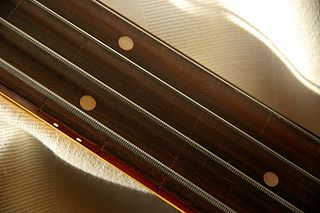
A string is the vibrating element that produces sound in string instruments such as the guitar, harp, piano, and members of the violin family. Strings are lengths of a flexible material that a musical instrument holds under tension so that they can vibrate freely, but controllably. Strings may be "plain", consisting only of a single material, like steel, nylon, or gut, or wound, having a "core" of one material and an overwinding of another. This is to make the string vibrate at the desired pitch, while maintaining a low profile and sufficient flexibility for playability.

The Gravikord is a 24 string electric double bridge-harp invented by Robert Grawi in 1984, which is closely related to both the West African kora and the mbira. It was designed to employ a separated double tonal array structure making it possible to easily play cross-rhythms in a polyrhythmic musical style in a modern electro-acoustic instrument. The Gravi-kora is a similar instrument, also developed by Grawi, which is tuned identically to a traditional 21 string kora.
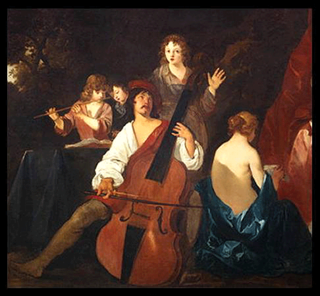
The term violone can refer to several distinct large, bowed musical instruments which belong to either the viol or violin family. The violone is sometimes a fretted instrument, and may have six, five, four, or even only three strings. The violone is also not always a contrabass instrument. In modern parlance, one usually tries to clarify the 'type' of violone by adding a qualifier based on the tuning or on geography, or by using other terms that have a more precise connotation. The term violone may be used correctly to describe many different instruments, yet distinguishing among these types can be difficult, especially for those not familiar with the historical instruments of the viol and violin families and their respective variations in tuning.
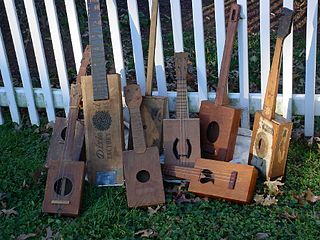
The cigar box guitar is a simple chordophone that uses an empty cigar box as a resonator. The earliest had one or two strings; modern models typically have three or more. Generally, the strings are connected to the end of a broomstick or a 1×2 inch wood slat and to the cigar box resonator.
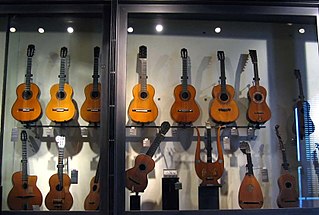
The following outline is provided as an overview of and topical guide to guitars:
In music, standard tuning refers to the typical tuning of a string instrument. This notion is contrary to that of scordatura, i.e. an alternate tuning designated to modify either the timbre or technical capabilities of the desired instrument.

An experimental musical instrument is a musical instrument that modifies or extends an existing instrument or class of instruments, or defines or creates a new class of instrument. Some are created through simple modifications, such as cracked drum cymbals or metal objects inserted between piano strings in a prepared piano. Some experimental instruments are created from household items like a homemade mute for brass instruments such as bathtub plugs. Other experimental instruments are created from electronic spare parts, or by mixing acoustic instruments with electric components.
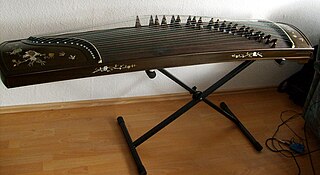
The yatga (Mongolian: ᠶᠠᠲᠤᠭᠠyatug-a, Khalkha dialect: ятга yatga; pronounced [ˈjɑtʰəq]; is a traditional plucked zither of Mongolia. It is derived from Kazakh jetigen with the word derived from “yatagan”; a synonym to “yetigen”.
References
- ↑ Bogdon-3 Description Archived July 10, 2011, at the Wayback Machine
- ↑ Sale Order Description
Bass Player Magazine January 2008


